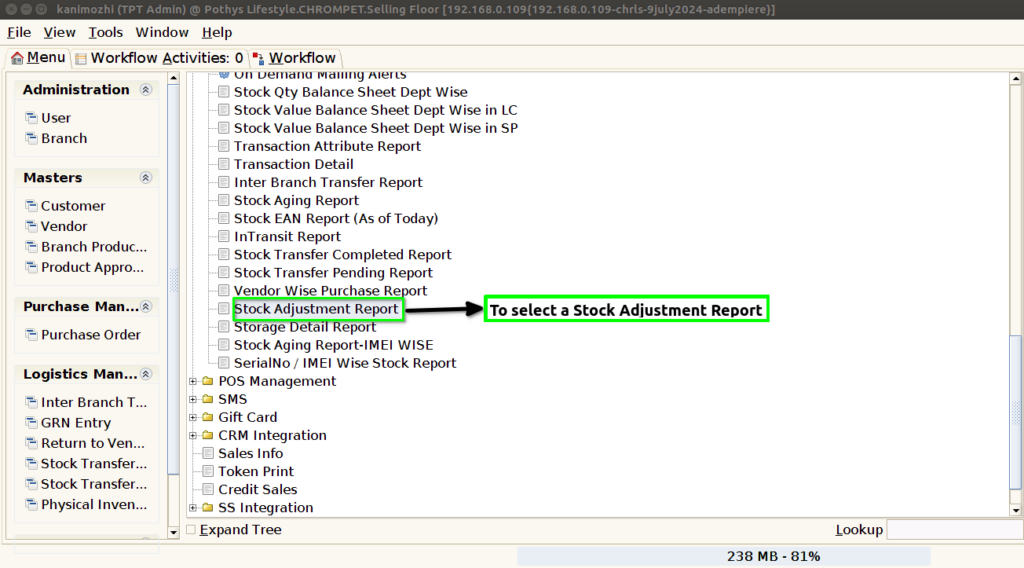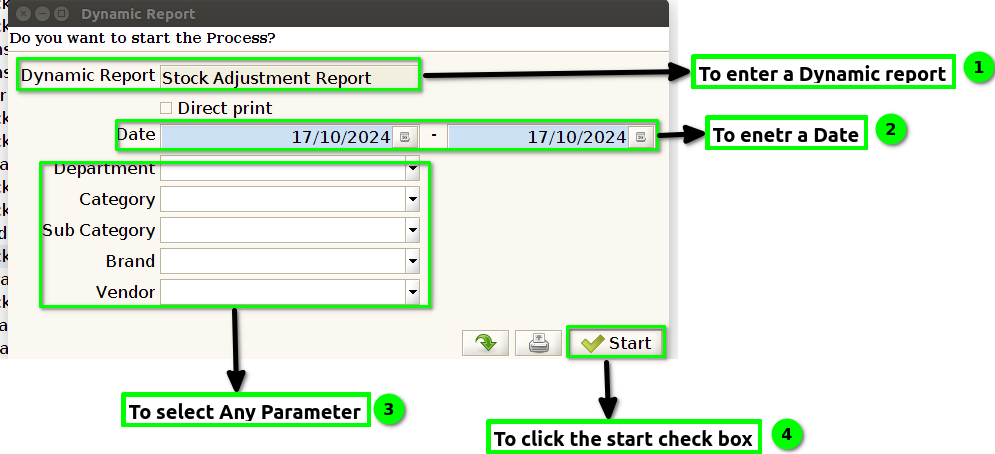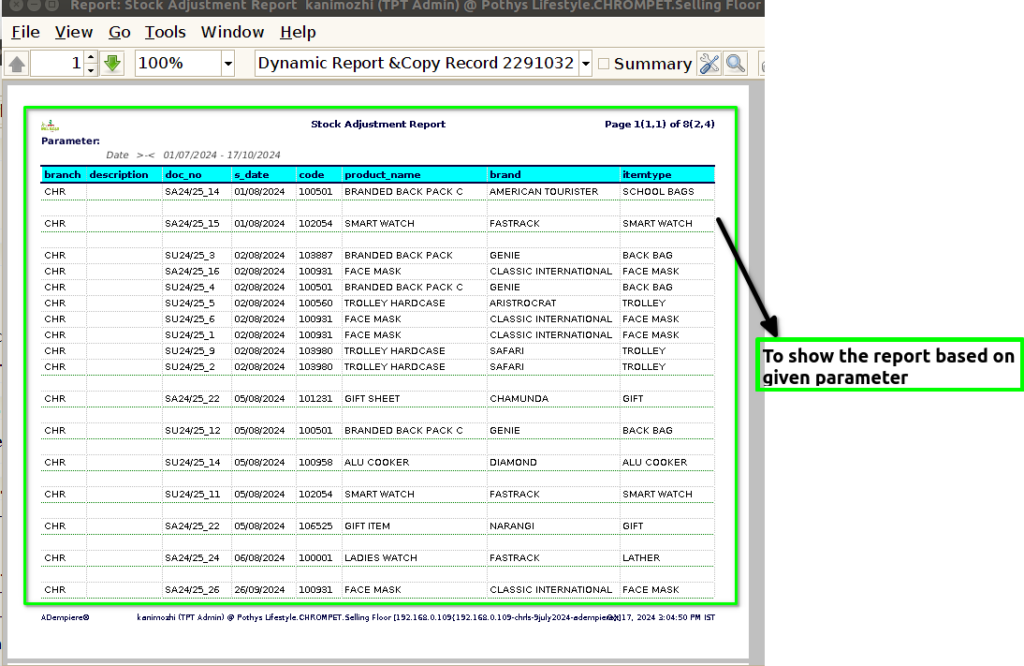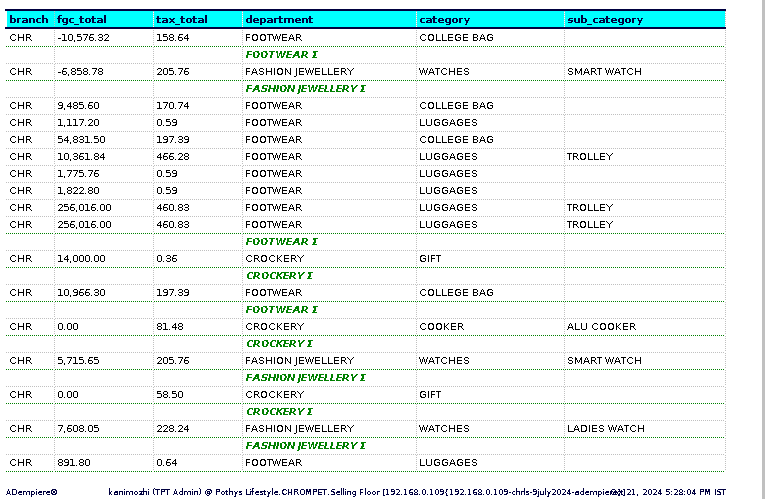TO CREATE A STOCK ADJUSTMENT REPORT
A stock adjustment report is a document used in inventory management that records changes in the quantity of stock on hand.Date of Adjustment: When the change occurred.Item Description: Details about the product being adjusted.Stock Levels: The previous and new quantities of the item.Reason for Adjustment: Explanation for the change (e.g., damage, theft, errors in previous counts, or restocking).Employee Responsible: The person who made the adjustment. These reports help businesses track inventory accuracy, identify issues in stock management, and ensure that financial records reflect the actual inventory levels. They can be essential for maintaining efficient operations and for financial auditing.
User Access
Who Can Access
- Pothys admin
- Head cashier
- Sales Manager
- manager
What User Can Do
- View Reports
- Stock Adjustment Report.
Pre-Requisite Activities
- Date
- Vendor
- Department
- Brand
- Category
Business Rules
- Authorization Requirement: All stock adjustments must be approved by a designated manager or supervisor to prevent unauthorized changes.
- Documentation: Each adjustment must be accompanied by detailed documentation, including the reason for the adjustment and supporting evidence (e.g., photographs, incident reports).
- Timeliness: Adjustments should be recorded promptly after the event occurs to maintain accurate inventory records.
- Clear Categorization: Classify adjustments into specific categories (e.g., damaged goods, shrinkage, restocking errors) to facilitate analysis.
- Consistent Format: Use a standardized template for reporting to ensure uniformity and ease of understanding.
- Audit Trail: Maintain a log of all adjustments, including who made the change and when, to ensure traceability for audits.
- Inventory Reconciliation: Conduct regular reconciliations of physical inventory against recorded inventory to identify discrepancies.
- Review Process: Implement a periodic review of adjustment reports to identify trends or recurring issues that may require attention.
- Integration with Financial Systems: Ensure that stock adjustments are reflected in financial records to maintain accurate accounting. By establishing these rules, businesses can enhance their inventory management processes and maintain better control over stock levels.
User Interface
STEP1: To select a Stock Adjustment Report.

STEP2: To enter a Dynamic Report field default update.And then to enter a Date. Then to select any Parameter based on our requirement.Finally to click the start check box.To run the process.

STEP3: Once to complete the process to show the report based on given parameter.




STEP4: Branch:Branch refers to a separate location or division of a larger organization, typically engaged in the same business activities as the main company.
Description: A description is a detailed explanation or account of a product, service, or item that provides information about its features, characteristics, and benefits. In marketing and sales, a good description helps customers.
Doc no: It is a unique identifier assigned to a specific document within a system or organization, used to facilitate tracking, retrieval, and management of documents.
Date: Date refer to as daily basis.
Product code,Name:A product code is a unique identifier assigned to a specific product or item, used to distinguish it from other products.A product name is the title or label given to a specific item that describes what it is or what it does. It helps customers identify and differentiate the product from others in the market.
Item type: Item type refers to the classification or category of a product based on its characteristics, usage, or purpose. This classification helps businesses organize their inventory, streamline processes, and communicate more effectively with customers.
Brand: A brand is a unique identity that distinguishes a company or product from others in the market. It encompasses various elements, including the name, logo, design, messaging, and overall reputation.
Product color,Design,Size: Product design is the process of creating and developing a new product or improving an existing one, focusing on functionality, aesthetics, usability, and user experience.Product color refers to the specific hue or shade assigned to a product, which can significantly influence customer perception and buying decisions.Product size refers to the physical dimensions or scale of a product, which can include measurements such as height, width, depth, and weight.
Adjustment Qty: Adjustment quantity refers to the amount by which inventory levels are modified to account for discrepancies, errors, or changes in stock.
MRP: MRP stands for Material Requirements Planning. It is a production planning, scheduling, and inventory control system used to manage manufacturing processes. The main goals of MRP are to ensure that materials and products are available for production and delivery while minimizing inventory costs.
Landed cost & Total: Landed cost refers to the total cost of a product once it has arrived at its final destination.Purchase Price: The initial cost of the product itself. 2. Shipping Costs: Charges for transporting the product, including freight and handling. Landed cost total is simply the cumulative sum of all these expenses, giving a comprehensive view of the actual cost incurred to acquire and deliver the product.
Final gross cost & Total: Final gross cost refers to the total expense incurred by a business to acquire a product or service before any deductions, such as discounts, rebates, or taxes. Final gross total is the cumulative amount of all these costs, providing a complete view of what has been spent on acquiring the product or service.
Tax Total: Tax total refers to the cumulative amount of taxes applied to a transaction or a series of transactions. This total includes all applicable taxes that must be paid in addition to the base price of goods or services. Sales Tax, Value-Added Tax (VAT), Excise Tax , Import Duties.
Department:A department refers to a distinct division within an organization or institution that focuses on a specific area of work, function, or set of responsibilities. Departments help organize and manage various aspects of a business or institution.
Category & Sub category :A category refers to a broad grouping of products or services that share similar characteristics or serve similar purposes.A sub-category is a more specific division within a category, allowing for further classification of products.
Vendor: A vendor is a person or business that sells goods or services to another entity, typically referred to as a buyer or customer.
Doc type Sub doc type: Doc type(Document Type) refers to a classification that identifies the nature or purpose of a document within a system or organization.Sub doc type (Sub Document Type) is a more specific classification within a broader document type. It allows for further differentiation based on specific characteristics or purposes.
Inv sub type: Inv sub type typically refers to “Inventory Sub Type,” which is a more specific classification within the broader inventory category.
Training Videos
FAQ
SOP